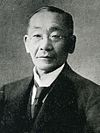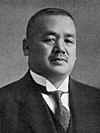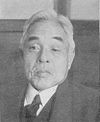
The House of Representatives is the lower house of the National Diet of Japan. The House of Councillors is the upper house.
Political parties appeared in Japan after the Meiji Restoration, and gradually increased in importance after the promulgation of the Meiji Constitution and the creation of the Diet of Japan. During the Taishō period, parliamentary democracy based on party politics temporarily succeeded in Japan, but in the 1930s the political parties were eclipsed by the military, and were dissolved in the 1940s during World War II
The League of Diet Members Supporting the Prosecution of the Holy War was a political party coalition in the lower house of the Diet of Japan formed on March 25, 1940, with the backing of the Imperial Japanese Army as a reaction against a speech made by Saitō Takao, of the Rikken Minseitō critical of the government’s aggressive policies in the Second Sino-Japanese War.

The Rikken Seiyūkai was one of the main political parties in the pre-war Empire of Japan. It was also known simply as the "Seiyūkai".
General elections were held in Japan on 20 February 1932. They were the last elections before the May 15 Incident, which marked the temporary end of party politics in Japan. Rikken Seiyūkai won 301 of the 466 seats in the House of Representatives.
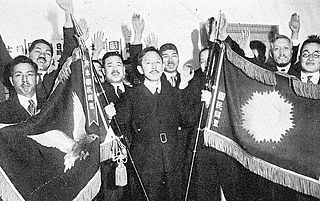
Kokumin Dōmei was a Japanese fascist political party in Japan active in the 1930s.

Rikken Minseitō was one of the main political parties in pre-war Empire of Japan. It was commonly known as the 'Minseitō'.
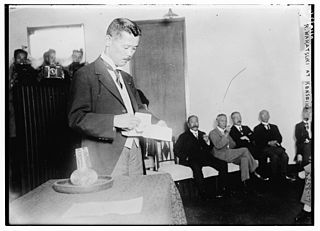
The Kenseikai was a short-lived political party in the pre-war Empire of Japan.

Fusanosuke Kuhara was an entrepreneur, politician and cabinet minister in the pre-war Empire of Japan.
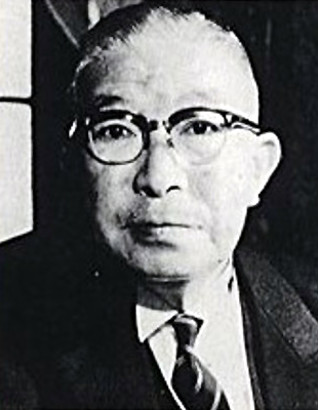
General elections were held in Japan on 10 April 1946, the first after World War II. Voters had one, two or three votes, depending on how many MPs were elected from their constituency. The result was a victory for the Liberal Party, which won 148 of the 464 seats. Voter turnout was 72.1 percent.

Ryūtarō Nagai, was a politician and cabinet minister in the Empire of Japan, serving a member of the Lower House of the Diet of Japan eight times, and four as a cabinet minister. He was noted in his early political career as a champion of universal suffrage, social welfare, labor unions, women's rights and Pan-Asianism.

Tsuneo Kanemitsu, was an entrepreneur, politician and cabinet minister in the Empire of Japan, serving eight terms as a member of the Lower House of the Diet of Japan, and twice times as a cabinet minister. He also served twice in the post-war Lower House of the Diet.

Yukio Sakurauchi was an entrepreneur, politician and cabinet minister in the pre-war Empire of Japan. He was the father of prominent post-war politician Yoshio Sakurauchi, and grandfather of controversial politician Seiichi Ota.

Magoichi Tawara was a bureaucrat, politician and cabinet minister in the pre-war Empire of Japan.
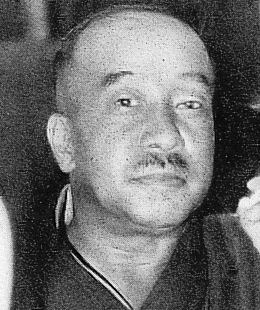
Kakichi Kawarada was a bureaucrat and cabinet minister in early Shōwa period Japan.

Takukichi Kawasaki was a politician and cabinet minister in the pre-war Empire of Japan.
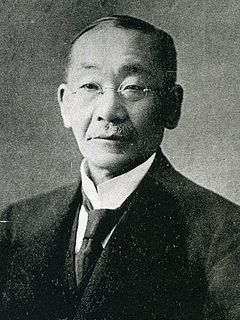
Machida Chūji was a politician and cabinet minister in the pre-war Empire of Japan.

Tatsunosuke Yamazaki was a Japanese was a politician and cabinet minister in the Taishō and early Shōwa periods of the Japan. His brother, Iwao Yamazaki was also a politician and cabinet minister, and his nephew Heihachiro Yamazaki was later a prominent member of the post-war Liberal-Democratic Party.

The 49th general election of members of the House of Representatives is scheduled on or before 22 October 2021, as required by the Constitution of Japan. Voting will take place in all Representatives constituencies of Japan including proportional blocks, in order to appoint Members of Diet to seats in the House of Representatives, the lower house of the National Diet of Japan. As the cabinet has to resign after a general House of Representatives election in the first post-election Diet session, the lower house election will also lead to a new designation election of the Prime Minister in the Diet, and the appointment of a new cabinet.




